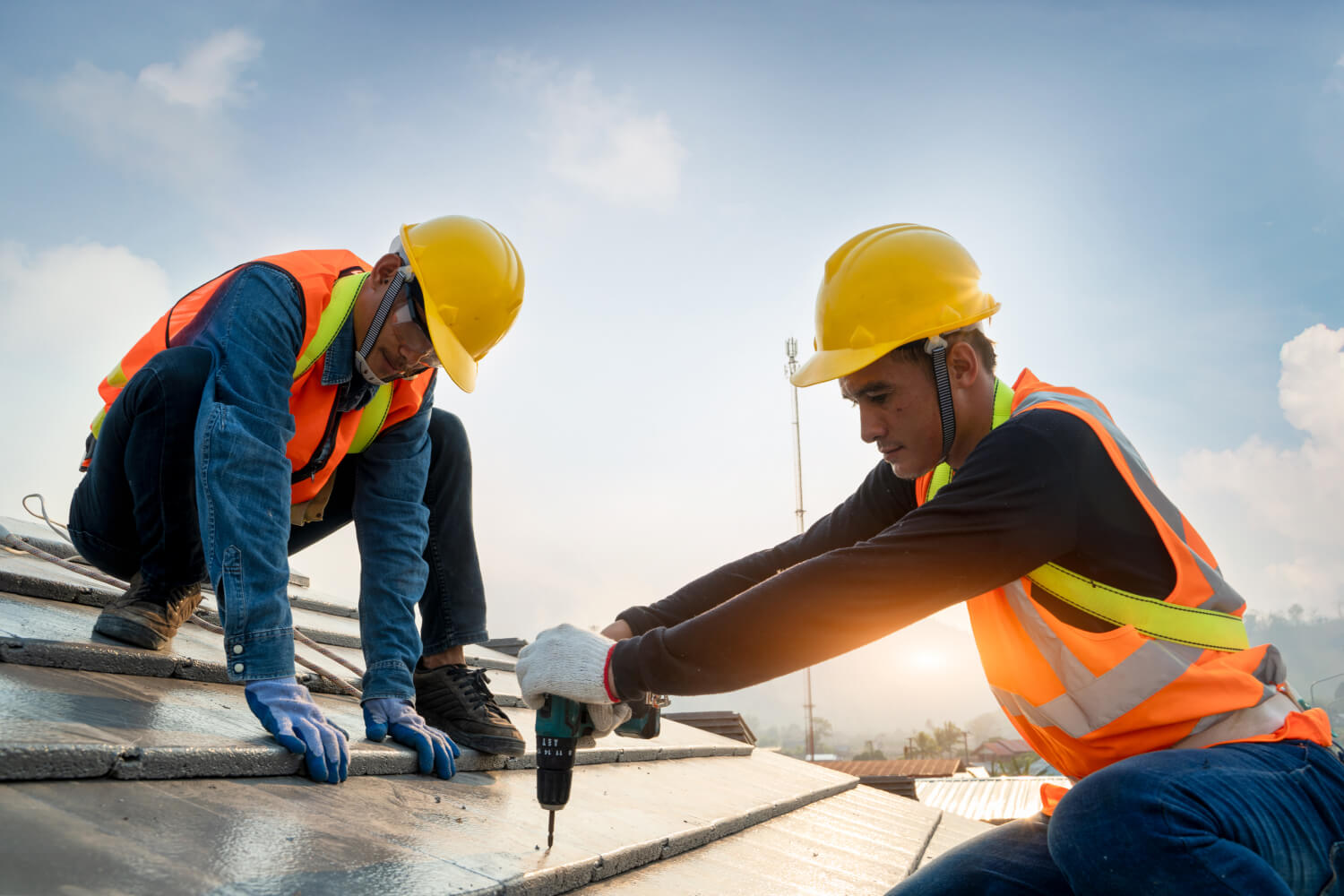Is it time for a new roof?
Sometimes when your roof leaks, it doesn't mean that you need a new roof. You may need to do some roof repairs instead of replacing the whole thing.
Replacing a roof is a costly and time-consuming venture. It's something you'll likely only do once, so you should only replace it when it's the right time.
- Your roof is nearing the end of its life.
- Your roof was poorly installed.
- Your roof suffered severe storm damage.
If you're not an experienced contractor yourself, it's best to find a reputable roofing contractor you can trust to give you an assessment of your roofing needs. First, you should do your own inspection and understand as much as you can about your roof.
Inspect your roof from two places.
- From the ground. Use binoculars as you walk around your home and look for cracked, curled, or missing shingles. Do you notice any excessive loss of the protective mineral granules?
- From your attic. With a flashlight, look at the underside of the roof deck and rafters. Make a note of any stains or wet spots that indicate water leaks.
What other physical damage may indicate it's time to replace your roof?
- Look for cracks, missing pieces, and bulging tiles.
- Look for splitting shakes that indicate exposure has rendered them soft or rotten.
- Don’t ignore missing shingles. Even a few missing shingles can expose your home to damage from harsh weather.
- Dips, curves, and humps in places that should be flat can indicate deteriorated trusses or rafters.
- If you see sunlight in the attic, there's a small hole in the roof somewhere.
- Damp spots or trails along the roof's support beams indicate roof leaks.
Have you seen a spike in your electric bill that you cannot account for? Time to inspect the roof and make sure it's not the source of the problem.
Make a note of what you find for the roofing contractor. If you're not an experienced contractor, you should not climb on the roof yourself. Follow strict safety protocols if you are a contractor for hire and do get on the roof.

Arm yourself with knowledge.
Understanding your choices in roofing materials and the pros and cons of each will help you make a better decision on when to replace your roof and with what. Use this guide to roofing materials as a starting point.
Understanding your roofing material.
Do you know when your roof was last installed and by whom? If you have a contract from that time, you should be able to find out your roof's expected lifespan.
What type of roof do you have now, and what type would you replace it with? This is a big decision to make. Here's a breakdown of the different types of roofing materials and what you should know about each one.
Slate Roofing
Slate roofing is one of the highest quality, longest lasting roofing materials, but it's not ideal for everyone. Here are some pros and cons you should consider.
Pros:
- Beautiful appearance with a variety of choices in colors, sizes, and thickness.
- Slate roofs can last a century. If the roof is properly constructed, 150 years is reasonable.
- One of the most fire-resistant roofing materials that exist.
- Positive environmental impact by lasting so much longer than other materials that go to the landfills.
Cons:
- Most contractors know very little about installing slate roofs but will do it anyway, leading to poor installation and a disappointing roof life expectancy.
- Slate roofs are very heavy, requiring that your home be evaluated to make sure it can handle the weight.
- Easily broken when walked on and very difficult to find perfectly matched replacement tiles.
- Significantly higher initial cost when installed.
Copper Roofing
Copper roofing can last for centuries when it's professionally installed and maintained. Copper has been used since the times of Ancient Egypt as a construction resource.
Pros:
- Resists corrosion, making it low maintenance.
- It's durable when properly installed and cared for.
- It's lightweight and won't stress your home structure.
- Most attractive metal roofing options.
- Color changes over time to become a blue-green patina.
- Copper roofs average 75% recycled content.
Cons:
- Most expensive roofing material on the market.
- Does not come with a warranty.
- Not many contractors are experienced in installing copper roofs.
Metal Roofing
Metal roofing panels pre-painted in different paint color finishes give you a more economical alternative to copper roofing.
- Include a standard limited paint warranty varying between 20-30 years.
- Metal roofing panels are durable, fire-resistant, lightweight, and eco-friendly.

Tile Roofing
Tile roofs can last 100 years, and they're beautiful. The tiles are made from molded, tinted concrete in curved, flat, fluted, or interlocking shapes. This is a great roofing material for homes in hot environments or exposed to sea air.
Pros:
- Durable, often coming with a 50-year warranty.
- Resistant to insect damage and rot.
- Energy-efficient.
- Low maintenance, unless broken.
- Can be pulverized and recycled when removed.
Cons:
- Expensive to buy.
- Difficult to install. Not a DIY project.
- Very heavy, so your home may need structural reinforcement.
- They break easily, and repairs can be costly.
- Only suitable for the sharper sloped roofs.
Wood Shake Roofing
Wood shake roofs appeal to people who prefer their rustic look for homes with country-style architecture. Before committing to a wooden shake roof, there are some things you should know.
Wood roofing material comes in shakes or shingles. Shingles are machine-sawn, while shakes are hand-split. Shakes are the better option because their construction makes for better wind and water resistance.
Wood shake roofs last around 30 years.
Pros of wood:
- One of the best insulating materials available.
- Shakes are wind resistant.
- Cedar and redwood shakes have shown to improve the stability of the entire roof deck when installed.
Cons of wood:
- High-maintenance requirements.
- Wood is flammable.
Fiber Cement Roofing
Fiber cement shingles can last about 15 years but come with some pros and cons you should consider.
Pros:
- It's cheap and readily available.
- The material is watertight and durable, making it a good choice for homes near the ocean.
- It can go up very quickly.
- Materials are safe.
- 90% plus of its composition is non-flammable.
- Resistant to insects, mold, and mildew.
- Available in a variety of colors.
- Versatile looks: can mimic wood shingles or planks and can be painted to look unique.
Cons:
- Susceptible to breakage in certain circumstances, which can affect durability.
- Long-term exposure to wind can lead to weathering and penetration of water.
- Costs two or three times more than other materials to install.
- Costs more in maintenance, as it needs repainting every 10-15 years.
- Needs regular professional inspections to maintain life expectancy.
Asphalt Shingle Roofing
Asphalt shingle/composite roofs have a life expectancy between 15 and 30 years. These are the most common type of roofing materials for homes in the United States.
- They're affordable.
- They're durable, based on the environmental conditions of where you live.
- They're versatile, with a broad range of colors, shapes, and textures available.
- They provide quality.
- They often come with a 25-year warranty.

About Solar Shingles
Solar shingles convert the sun's radiation into usable electricity while functioning as your home's roofing material. They're commonly shaped into shingles or tiles and seamlessly arranged.
Pros:
- Ideal option when it's time to replace an existing roof.
- Elegant and sleek look.
Cons:
- High upfront costs.
- Less energy efficiency than standard solar modules.
- Not many professional installers are available.
About Solar Panels
Here is a short FAQ about adding solar panels to your new roof.
- Solar panels last about 25-30 years.
- Installing solar panels may qualify for a federal tax credit for solar photovoltaics and other incentives.
- Homes with solar panels often sell faster than those without.
- If money is an issue, you may be able to lease them or sign a power purchase agreement.
Factors that impact your roof's life expectancy.
Even with the most durable of roofing materials, there are some factors that may lower your roof’s life expectancy.
- Installation workmanship. If the roof is poorly installed, this will shorten your roof's life dramatically.
- Environment. Extreme temperatures, high winds, frequent hail, and other damaging environmental factors can cut years off your roof's lifetime.
- Cheap materials. While they may save you money at the installation time, they won't last as long as high-quality roofing materials.
- Material type. Different materials come with varying rates of durability.
- Maintenance. A well-maintained roof will last longer, while ignoring the roof can shorten its life.

The current supply chain status.
If you're going to replace your roof this year, keep in mind that the effects of the supply chain crisis are still in effect. According to Associated Builders and Contractors, construction materials are up 23.7% this April compared to last year.
If you're an experienced handyman replacing the roof yourself, you may still see delays getting all your materials in. If you're using a contractor, they may have a long wait time for an opening to do your roof and get your materials in.
These factors are expected to last well into the year for a while yet, but you can still make a satisfying decision for your home with a bit of roofing knowledge.
By maintaining and repairing your roof as needed, you’ll get the best roof life expectancy possible. With some forethought and planning, you’ll add value and safety to your home when it comes time to replace your roof.







